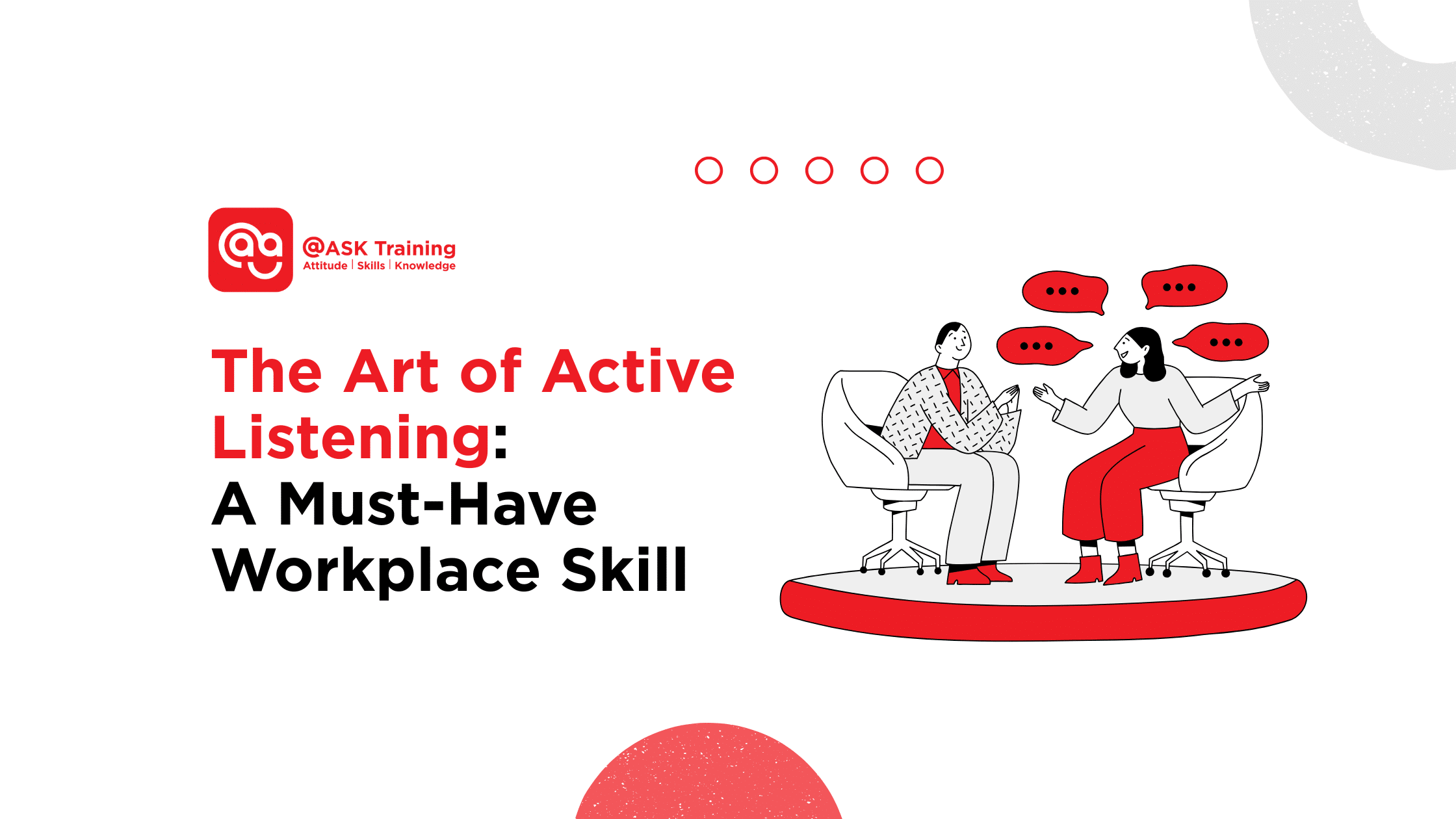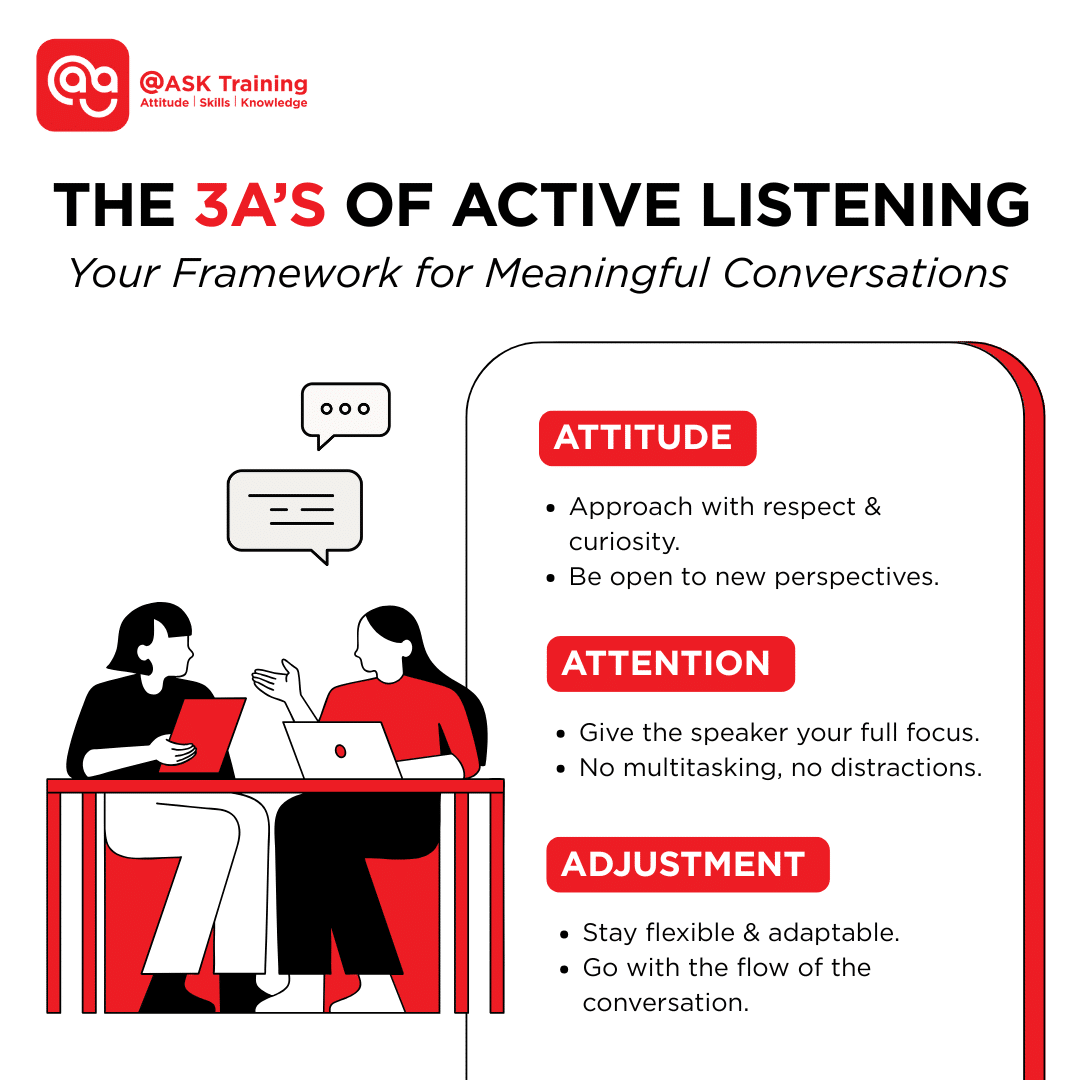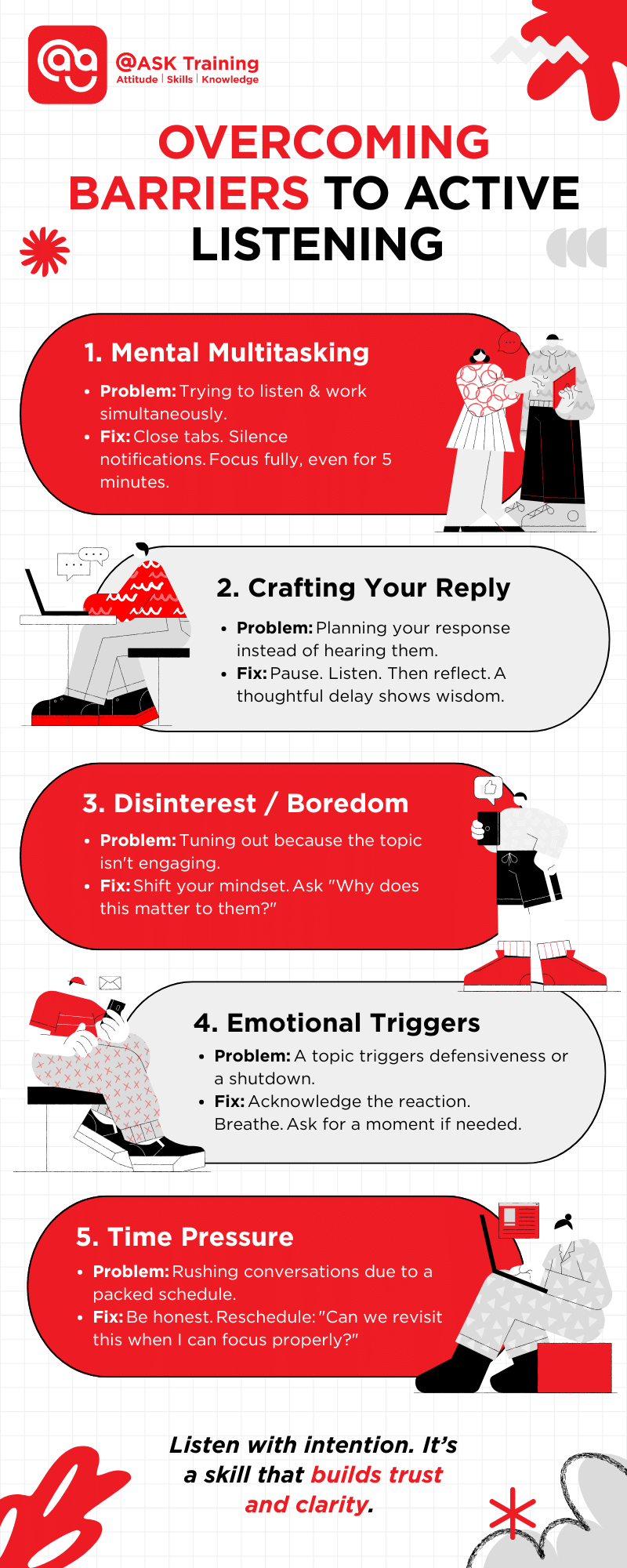 In a world where we spend half our meetings staring blankly into Zoom screens and the other half nodding while secretly drafting emails. It’s safe to say that active listening in the workplace is harder than it should be.
In a world where we spend half our meetings staring blankly into Zoom screens and the other half nodding while secretly drafting emails. It’s safe to say that active listening in the workplace is harder than it should be.
But fear not — we’re not just here to help you fake it ‘til you make it — we’re here to equip you to listen like a pro.
Whether you’re a team lead trying to avoid yet another miscommunication over chat or an HR hero building inclusive communication across departments, learning how to actively listen could be your workplace superpower.
For leaders and managers especially, this isn’t just a soft skill, it’s a fundamental trait that sets the standard for your entire team’s success.
By the end of this guide, you’ll walk away with:
- A clear understanding of active vs. passive listening (one involves eye contact, the other often involves mentally planning your next vacation).
- Practical frameworks and concepts designed for real-world application.
- Insights that will make learning engaging and impactful.
Now that we’ve set the stage, let’s dive into what it truly means to listen effectively and why it holds such significant weight in any professional setting.
What is Active Listening and Why It Matters
Let’s be honest: most of us hear, but we don’t truly listen. Hearing is simply the reception of sound, like what happens when your boss talks about deadlines while your mind is already on a beach.
Active listening, however, is far more than just being quiet while someone else speaks. It’s the intentional act of being fully present — mentally and emotionally — in a conversation. This means:
- Giving someone your full attention.
- Withholding judgment and assumptions.
- Responding in a way that truly confirms understanding.
So why does it matter in the workplace? Let’s break down the benefits of active listening:
- It builds trust: When individuals feel genuinely heard without interruption or dismissal, they’re far more likely to open up, share ideas, and communicate honestly.
- It boosts motivation: Employees who feel listened to consistently report feeling more valued and engaged.
- It strengthens communication: Active listening reduces misunderstandings, clarifies expectations, and leads to better decision-making.
When people feel genuinely heard, their engagement soars, fostering a healthier, more collaborative workplace culture. This is the foundation of psychological safety and high-performing teams.
Listening skills for leaders are especially critical, as leaders set the tone for how effective communication is handled within teams. The ability to listen actively is what separates good managers from great, influential leaders.
Understanding the profound impact of active listening is just the first step; next, let’s break down the fundamental components that make up this essential skill.
Core Elements of Active Listening
True active listening goes beyond a simple “uh-huh”. It involves specific practices that demonstrate your full engagement.
For leaders, demonstrating these components visibly models the behaviour for their entire team.
The 3 A’s: Your Listening Survival Kit

- Attitude: Respect the speaker. Stay open and curious, even if you think you’ve heard it all before.
- Attention: This demands your full focus – that means no emails, no multitasking, and definitely no daydreaming.
- Adjustment: Be flexible. Conversations can shift unexpectedly; your goal is to adapt without showing visible alarm.
Body Language: Your Silent Partner
- Eye contact: Maintain a steady and attentive eye contact, ensuring it’s neither intense nor glazed over.
- Nodding: Use nod sparingly to show you’re engaged, avoid the “bobblehead” effect.
- Open posture: Uncross your arms to demonstrate openness, not defensiveness.
Reflective Listening: The Magic Phrase
“So what I’m hearing is…”
This phrase is your best friend when learning how to actively listen. It can:
- Diffuse tension.
- Clarify intent.
- Make you sound emotionally intelligent, even if you’re just confirming details.
Active Listening in Action: Practical Examples
Let’s see active listening applied in common workplace scenarios:
Example: In a Virtual Meeting
Scenario
You’re in a Zoom call where a quieter team member finally speaks up with concerns about a new process.
Team Member
“Honestly, I’m still not clear on how this new workflow will affect my role. I’m not sure I’ll have enough support.”
You (Attitude + Attention)
Turns camera on, makes eye contact, pauses to let them finish speaking.
You (Reflective Listening)
“Thanks for raising that. What I’m hearing is that you’re unsure how your responsibilities fit into the new workflow, and you’re concerned about the level of support you’ll get. Did I get that right?”
Team Member
“Yes, I just don’t want to be set up to fail.”
You (Adjustment)
“Completely fair. Let’s walk through your part in the process after this call and see where we can clarify roles or provide extra resources.”
Why it Works: You stayed focused, acknowledged their concern, and adapted the conversation to give clarity and reassurance, even over video. This leader’s response didn’t just solve a problem; it reinforced a culture where it is safe to voice concerns.
Example: During a Performance Feedback Session
Scenario
A direct report becomes defensive during a performance review or a feedback conversation.
Team Member
“I feel like you’re only pointing out what I’m doing wrong. What about the deadlines I’ve met or the ideas I’ve contributed?”
You (Attitude + Attention)
Maintain a calm tone and open body language.
You (Reflective Listening)
“It sounds like you’re feeling that your efforts aren’t being fully recognised, and that’s making this conversation feel unbalanced.”
Team Member
“Exactly. I’m not saying I’ve been perfect, but I’ve worked hard.”
You (Adjustment)
“I appreciate you saying that. Let’s take a step back — I’d like to acknowledge the progress you’ve made, and then we can talk through the areas where you still have room to grow.”
Why it Works: You validated their emotion without backing away from the discussion. By adjusting your approach mid-conversation, you reduced defensiveness and kept the dialogue productive. This is a hallmark of a people-centred leader who balances honesty with empathy.
Now that we’ve explored the fundamental elements of active listening and seen it in action, let’s discover how leaders can leverage this skill to create a powerful ripple effect throughout their entire team.
Leadership and the Listening Multiplier Effect
Great leadership isn’t just about giving orders or setting goals — it’s about creating an environment where ideas, feedback, and innovation can genuinely flourish. At the heart of this dynamic lies active listening.
When leaders truly listen, they don’t just absorb information; they amplify it. Think of a leader as a trampoline: instead of just taking in ideas, they bounce them back, energised and more powerful.
This “listening multiplier effect” means that the energy, creativity, and engagement of team members grow exponentially. This demonstrates a key aspect of emotional intelligence (EQ), distinguishing highly effective leaders.
It is how leaders become champions for their teams, transforming individual contributions into collective success.
Here’s why it matters:
- Improved feedback loops: When leaders listen carefully, feedback becomes a two-way street. Employees feel safe sharing honest thoughts, leading to continuous improvement.
- Conflict resolution: Active listening helps leaders understand the root causes of conflict rather than just surface complaints, enabling them to mediate effectively.
- Encouraging innovation: By validating and building on team members’ ideas, leaders create a culture where innovation thrives — people know their contributions matter.
- Stronger relationships: Listening fosters trust and respect, key ingredients for any successful team.
Ultimately, leaders who master active listening set the tone for their entire organisation. They show that every voice counts, every idea has value, and collaboration is a shared responsibility.
Gain better insights on how to build EQ as a manager with our article: Why Emotionally Intelligent Managers Outperform Everyone Else.
The impact of a listening leader is clear, but how can organisations move beyond individual efforts to embed active listening as a core part of their entire culture?
Let’s explore strategies for building a truly listening workplace.
Building a Culture of Listening at Work
Effective communication in teams doesn’t just happen; it requires intentional effort, clear structure, and a few brave individuals willing to say, “Hey, let’s actually listen to each other.”
Leaders play a crucial role in championing this cultural shift.
Here’s how you can cultivate a listening culture:
- Include “reflection moments” in meetings: Dedicate 30 seconds for team members to paraphrase what they’ve heard or ask clarifying questions. This simple pause helps everyone feel understood.
- Coach managers on active listening: Provide training and ongoing support to help leaders develop and consistently practice strong listening skills.
- Recognise and reward great listeners: Celebrate individuals who demonstrate exceptional listening through shout-outs, awards, or incorporating it into performance reviews.
Investing in listening skills for leaders at all levels, from supervisors to senior management, can dramatically shift how communication flows within your organisation. When leadership genuinely listens well, teams will naturally follow suit.
Tools and Steps to Support Listening
- Meeting check-ins: Begin meetings with a quick “how is everyone feeling?” round to promote presence and empathy.
- Use collaborative platforms: Tools like Slack, Microsoft Teams, or Miro can help document and clarify conversations, making sure nothing is missed.
- Listening workshops: Host periodic sessions to practice listening skills, share challenges, and celebrate progress.
- Visual cues: Encourage nonverbal signs of listening, like raising hands or using reaction emojis during virtual meetings to maintain engagement and support effective communication in teams working across hybrid setups.
The Ultimate Goal?
Creating a workplace where people feel safe to speak up, share disagreements, and be their authentic selves — all without the need for forced team-building retreats.
As our workplaces increasingly embrace remote and hybrid models, the dynamics of listening evolve. Let’s explore how to maintain strong active listening skills even when physical presence is limited.
Adapting Active Listening for Remote and Hybrid Teams
Remote and hybrid meetings certainly present unique challenges to active listening. Distractions are everywhere, body language cues are limited, and it’s easy to zone out (or pretend your Wi-Fi froze).
Yet, listening well in virtual spaces is absolutely essential. It builds trust, reduces miscommunication, and keeps everyone aligned even across time zones.
Here’s how to stay engaged and connected, even when you’re miles apart:
1. Turn Your Camera On (When Possible)
It’s significantly easier to listen and feel listened to when you can see each other’s faces. Eye contact, nods, and facial expressions all help build connection and show that you’re present.
2. Minimise Multitasking
Tempted to check email or finish that spreadsheet during a meeting? Resist the urge. Multitasking weakens your ability to listen, and people can usually tell when you’re not fully present.
3. Use Names and Cues
Address people by name and reference their points (e.g. “As Jane mentioned earlier…”). This signals attentiveness and keeps everyone mentally engaged.
4. Normalise Pauses and Silence
In virtual meetings, people often rush to fill the silence. But a short pause gives people time to reflect, process, or speak up, especially those who are more introverted or need time to formulate their thoughts.
5. Use Chat and Emojis Wisely
Don’t underestimate the power of a quick “👍” or “That makes sense” in the chat. These small responses offer real-time feedback and show you’re engaged, even when you’re not speaking.
6. Summarise and Check For Clarity
Wrap up discussions with quick summaries and invite clarification: “So what I’m hearing is X — does that sound right to everyone?” This mirrors reflective listening and avoids assumptions.
Even with the best intentions and strategies, common barriers can derail our active listening efforts. Let’s identify these hurdles and equip ourselves with practical ways to overcome them.
Overcoming Barriers to Active Listening
We understand! You’re juggling deadlines, chat pings, calendar invites, and your third reheat of coffee. In today’s fast-paced work culture, active listening can feel like a luxury.
However, ignoring these barriers inevitably leads to miscommunication, missed details, and frayed relationships.
Here are the most common listening blockers, and how to overcome them:
1. Mental Multitasking
- You believe you can listen and reply to emails at the same time.
- Fix: Close unnecessary tabs, silence notifications, and give the conversation your full focus, even if it’s just for five minutes.
2. Prepping Your Reply While They’re Still Talking
- If you’re crafting your comeback instead of absorbing what’s being said, you’re not really listening.
- Fix: Pause. Listen fully. Then reflect before you respond. The slight delay won’t make you seem slow; it’ll make you sound wise. This is a mark of a thoughtful leader.
3. Disinterest or Boredom
- Not every conversation lights a fire in your soul. But tuning out entirely signals disrespect.
- Fix: Shift your mindset. Instead of zoning out, try to learn why this matters to the speaker. Ask questions to maintain engagement. A leader’s job is to find the value in every team member’s contribution.
4. Emotional Triggers
- Certain topics or tones can hit a nerve, leading to defensiveness or a complete shutdown.
- Fix: Acknowledge your reaction. Take a breath. If you need space, say, “Can I take a moment to think about that?” This self-regulation is a critical leadership skill.
5. Time Pressure
- When your calendar is packed back-to-back, with barely a moment to breathe, it’s tempting to rush conversations or tune out.
- Fix: Don’t fake it. Be honest. Try saying, “I want to give this my full attention — can we revisit it when I’m able to focus properly?”
- Rescheduling is a more respectful choice than offering divided attention.
Here’s a quick recap:

Conclusion: Listen Like You Mean It
If there’s one workplace skill worth mastering, it’s this. Active listening in the workplace doesn’t just make you a better colleague — it makes you a better person.
Active listening fuels effective communication, builds inclusive communication norms, and lays the foundation for psychological safety at work.
So the next time someone says, “Can I run something by you?”, pause, turn off your notifications, and really tune in.
Who knows? You might even find yourself enjoying the deeper connection and understanding that comes from truly listening.
Check out these resources for more active listening hacks:
- How Leaders Can Build Psychological Safety at Work
- 4 Listening Skills Leaders Need to Master
- A Leader’s Guide to Active and Reflective Listening
Ready to Enhance Your Communication Skills Further?
Team up with @ASK Training to be your ally in this transformative journey! Our comprehensive courses are designed to meet the unique needs of both leadership and individual contributors.
For Managers and Leaders
Equip yourself with advanced communication and active listening strategies to inspire and empower with our Leadership and Management courses, including:
- Enhancing Your Emotional Intelligence: The Key To Effective Leadership
- People-Centred Leadership – Motivating, Inspiring and Engaging Others
- Delivering Constructive Feedback Effectively
For Individuals/Team Members
Take control of your personal and professional growth! Our Personal Development courses are designed to hone your listening skills, making you a more effective communicator and a highly valued team member. Explore:
- The Art of Conversation Mastery
- Master Your Message with Powerful Body Language
- Birds of Different Feathers Can Flock Together
Get in touch with us today and transform your communication one conversation at a time!
Related Courses
- Mastering Emotional Intelligence: Your Key to People Management Excellence!
- People Centered Leadership- Motivating, Inspiring and Engaging Others
- Empathy: Harnessing The Power of Connection at Workplace
◆◆◆
